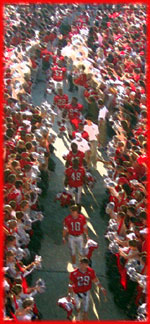Tuesday April 24, 2007
Sportsline’s Gary Parrish points out today that recent changes among the SEC’s men’s basketball coaches have left the league with only one minority coach, Georgia’s Dennis Felton.
I won’t even address his suspect stretch to link another bizarre Arkansas personnel decision with a conference-wide backlash against minority coaches.
But I will ask this question: does such hysteria when a minority coach is fired make programs more or less likely to take a chance on a minority coach in the future?
(Don’t tell Parrish, but it’s even worse than it appears. Three of the four vacant SEC women’s basketball coaching positions this spring – all formerly held by women – went to men.)
Monday April 23, 2007
Georgia fans will give you endless excuses why we never draw more than 20 or
30,000 people to the spring scrimmage. After all, other teams draw 50,000 or
even more for their scrimmages. You’ll hear about Masters weekend or sometimes
Easter weekend or the weather or Richt’s tendency to play the scrimmage as vanilla
as possible. It’s always something, and that’s just fine with me.
Let’s be honest. You’re watching a scrimmage. You have no emotional stake in
the outcome. Your greatest concern is that everyone remains healthy. The only
reasons for going are to spend a day in the ol’ college town, stock up at the
bookstores, entertain the kids, and sit a lot closer to something resembling
football than you otherwise could in the fall. Football practice is boring once
you get over the novelty, and that’s why I’m glad that most Dawg fans usually
can find better things to do when G-Day comes around each year.
Over 92,000 Alabama fans had nothing better to do on Saturday than to attend
A-Day in Tuscaloosa just to be a part of Nick Saban’s first public appearance
on the Bryant-Denny sideline. Fans actually used words like "historic"
to describe a football scrimmage. Far be it from a sportsblogger to play the
"obsessive to the point of unhealthy" card, but damn. The
coverage of the crowd also serves to remind the rest of us that Alabama football
fans are similar to Kentucky basketball fans in that same kind of arrogantly
annoying way. We don’t enjoy them being down as much as we would, say Auburn
or Florida, but just know how insufferable they’ll be if Saban actually does
do something there.
Someone on the DawgVent asked what the turnout was for Richt’s first G-Day
game back in 2001, and I came across this
recap from UGASports.com. If ever G-Day was set up for a huge crowd, it
was that day. You had a triple-shot of hype: Richt was bringing his shiny FSU
offense to Georgia. G-Day returned to Sanford Stadium after skipping a year
due to that infamous sewer leak. Finally, fans got their first look at quarterback
phenom David Greene. Despite all of those things that might have made G-Day
2001 ever so slightly more interesting than usual, I’m very glad to say that
only 20,445 showed up in Athens on that day.
We’ve known for years that it’s a quirk of these spring games that some unusual
suspects can steal the show. Georgia has had Johnny Brown, Ronnie Powell, and
even Jason Johnson – the heros of spring games past. 2001 was no different.
With several players held out due to injury, you need to dust off a media guide
to follow the recap.
Much like 2006, the quarterback position was a question mark and a big area
of interest. It was clear by that point that Quincy Carter was long gone. Cory
Phillips, the caretaker quarterback of the 2000 season, was given the opportunity
to win the position. Fans were eager to get a look at redshirt freshman David
Greene after hearing the hype during his redshirt season in 2000. Matt Redding
didn’t last long at quarterback after the spring. He’d be tried at linebacker
and eventually left the program. Neither Greene nor Phillips looked very impressive
against the first-string defense, though Greene threw two touchdowns. Coach
Richt would not name a starter until the week before the 2001 season.
Incumbent tailback Musa Smith was held out of G-Day 2001, so the running game
wasn’t really on display. Even Jasper Sanks was out. Georgia’s leading rusher
that day was the forgotten Bailey, Kenny. Kenny spent some time as a reserve
tailback before trying his luck as a defensive back later in his career. You
can’t mention G-Day during this era without mentioning Ronnie Powell. Powell
scored the game’s lone rushing touchdown and averaged over 10 yards on his four
carries. Lurking down among the running backs was a fullback named Verron Haynes.
The receiving stats were particularly interesting. The top two receivers in
the game became known more for leaving Georgia than for anything they did in
Athens. Durrell Robinson came to Georgia as a partial qualifier, made a few
receptions in 2000, and was off to junior college not long after this spring
of 2001. Robinson became one of the nation’s best JUCO receivers and committed
to West Virginia before dropping off the face of the earth. Tavarus Morgan also
left Georgia during 2001, and he settled as South Carolina State where he had
a decent career. Standouts Randy McMichael, Terrence Edwards, and Damien Gary
didn’t have stellar performances, but that’s not unusual for G-Day.
Georgia’s leading tackler that day? Safety Burt Jones. Jones would go on in
his career to become (quite seriously) one of the best cover guys Georgia has
had on special teams in some time. Right behind Jones was safety standout Terreal
Bierria who scored eight tackles and was involved with two interceptions. The
defense tallied four interceptions overall.
Sophomore Billy Bennett was the game’s leading scorer. He connected on five
field goals (a sixth was blocked) in a foreshadowing of his record-setting six
field goal performance that was to come much later in 2001 during the streak-breaker
game at Georgia Tech.
How in the world did only 20k show up for that?!?!
Friday April 20, 2007
It’s been about a year and a half since University of Georgia students approved
a fee to construct "Tate
2 ", an expansion of the Tate Student Center at the heart of campus.
(Students of my era can relate to a fee for a building – the SPACENTER, now
the Ramsey Center – which wouldn’t be finished until we were long gone.) After
a delay, groundbreaking finally took place on the project on Thursday.
 Though the plans have been scaled back a bit, the
concept is still the same. The first phase will be to build a 500-space
parking deck in the lot (N11) below the bookstore and adjacent to the Tate Center.
Once that parking deck is completed, it will become operational as the Tate
Expansion is constructed on top of it. If you think about the landscape in that
area, it makes sense…there’s a big slope from the new Student Learning Center
down to Tanyard Creek (the location of the Dawg Walk), so the top of this "underground"
parking deck will be at ground level for the bookstore and Student Learning
Center.
The project will transform the area that has become, thanks to the Dawg Walk,
the "front door" to Sanford Stadium. Once the parking deck is completed,
the remainder of the parking spaces in Dawg Walk Land will be converted into
green space as part of a rehabilitation of the Tanyard Creek area. Original
plans even included a "Dawg Walk Overlook" on top of the new parking
deck next to the Tate Expansion. You
have to see the conceptual drawings to really understand the project.
For those of us used to a sea of asphalt from the bookstore down to Gate 10,
it will be a big chance to the central part of campus. The hulking Student Learning
Center has already changed the look of the area, and this new development will
take the next step. The original plans also call for a future "Alumni
Development Center" along Lumpkin Street which will join with the Tate
Expansion to mirror the SLC and create a plaza from the Baxter/Lumpkin intersection
through to Sanford Drive.
If you’re reading this site, you’re probably more concerned with the impact
on football than you are with the aesthetics of the campus master plan. The
first obvious impact is parking. Once the project is completed, there will be
a shiny new 500-space parking deck to replace the spaces lost to the new Tate
Expansion and the green space along Tanyard Creek. In the meantime, those spaces
at the site of the former UGA police headquarters and Stegeman Hall (lot N11)
will be unavailable. While most of us don’t dream of parking that close to Sanford
Stadium, the temporary loss of those spaces will probably push some of those
with prime reserved spots further out into campus. The lot leading up to the
stadium where the Dawg Walk takes place will remain until the deck is ready.
The broader impact to football fans will be to the gameday experience. If this
is done right, I think the changes will eventually be very positive. The green
space planned for the area could become a popular gathering area, assuming of
course that UGA doesn’t claim it first as a "family-free-friendly"
zone or allow the corporate tailgates to take over that prime space in close
proximity to the stadium. Currently that entrance to the stadium is a massive
parking lot in a bowl bordered by a creek that more closely resembles a drainage
ditch. The Dawg Walk should be enhanced as fans can enjoy the plaza and not
have to navigate parked cars in order to join in the experience.
Wednesday April 18, 2007
The NCAA’s tomes governing permissible contact between a prospect and a coach
have been behind the technological curve. Traditional methods of contact such
as phone calls or face-to-face meetings have been successfully regulated. Even
e-mails and faxes have been regulated to some extent. But coaches have found
loopholes in the rules and can send (and receive) text messages with the frequency
of a sugared-up pre-teen. Isn’t that right, Coach Nutt? Most coaches, whether
they admit it or not, can work a Blackberry in their sleep now. Let’s not put
all of this on coaches – you’d be amazed how many text conversations are initiated
by the prospects.
For the coach, the technology is a mixed blessing. You have the ability to
contact your prized prospects at any time with brief, casual messages using
the kids’ prefered method of communication. But that same ease of communication
applies to your competition. You don’t want to be second to congratulate the
guy (or girl) on a great game, and the immediate access means that you are tethered
to the technology lest your rival develop an advantage. Some prospects live
for the constant attention, but most find it intrusive.
With all that in mind, the NCAA
Division I management council has recommended "a ban on all electronically
transmitted correspondence, including text messages, between coaches and recruits."
E-mails and faxes would be exempt because they are covered under existing guidelines.
The NCAA intentionally used the broad brush of "all electronically transmitted
correspondence" in order to cover the pace of technological change that
can adapt faster than the ability to regulate it. "The reality is that
it does keep us a little bit ahead of the curve, for now," said committee
chair Kate Hickey.
Coaches naturally are concerned that the ban would eliminate a channel of communication
that is familiar to the prospects and their families. Kids communicate through
text messages, and being able to relate to how they communicate goes a long
way for a coach. Many kids have given up e-mail entirely. I think most coaches
though will secretly breathe a sigh of relief – you can’t put the genie back
in the lamp, but they might at least get some sleep now.
The AP article is correct that enforcement of the ban will be challenging.
I imagine that if anyone gets busted it will be because some annoyed prospect
turns in a coach who won’t leave him alone.
The NCAA will decide the fate of the ban at its April 26 Board of Directors
meeting. If adopted, the ban would take effect in August.
It’s worth noting the other proposed rules change in that article. Currently,
student-athletes may not try out for a professional team if they are enrolled.
This seems absurd. We’re trying to graduate student-athletes, but we force those
with professional aspirations to drop out of classes for what amounts to a job
interview. In a wise change, the committee passed a recommendation "that
would allow athletes to receive money from pro teams to make a 48-hour trip.
Or they could also pay the bill themselves and not be bound by the time limit."
The only gotcha, which seems fair, is that the kid would not be allowed to miss
class for the tryout. Adopting this change seems even more important to me than
the text message ban.
Monday April 16, 2007
At least 20 are dead in a Virginia Tech campus shooting.
Friday April 13, 2007
A pretty cool project going on in Blacksburg: when Beamerball has its players flying around the football field this fall, several players will have helmets outfitted with accelerometers and wireless transmitters to record impact forces. 300,000 of the 1.5 million traumatic brain injuries nationwide each year are to athletes, and football has more of them than any other sport.
Though the system will collect and store the data for research, it will also provide some real-time feedback that can alert team doctors to signs of trouble before a player notices a problem or if a serious impact is missed during the hectic action of a game.
“We have a pager that alerts me when we receive a high head acceleration,” (team physician Dr. Gunnar Brolinson) said. “We set the pager at 98g – an impact of 98 times the force of gravity at the Earth’s surface – . We think that’s a fairly significant head acceleration.”
Brolinson noted that if he’s alerted to such a blow to the head of a player, then he watches the player for signs of a concussion.
One very interesting result so far is the common-sense finding that different positions receive different impacts, and that might lead to additional equipment refinements.
Brolinson said that so far the study of Virginia Tech’s football players has turned up some interesting and useful data, the most notable being that different positions apparently sustain different types of blows.
“Linemen sustain frontal blows. They’re usually low impact blows, but there are lots of them. Wide receivers receive fewer blows, but get higher blows when they happen. Linebackers sustain higher accelerations than linemen.”
Brolinson said that he thinks the data developed by the instrumented helmets may lead to changes in football equipment. “One of the things that may come out of this research, as we start to understand the blows, is position specific helmets. A lineman may need a different helmet from a wide receiver,” he said.
The work should have applications across athletics, in the military, and even in automobile safety.
(HT: Engadget)
Here’s Charles Johnson about to provide a data point to QB Sean Glennon:
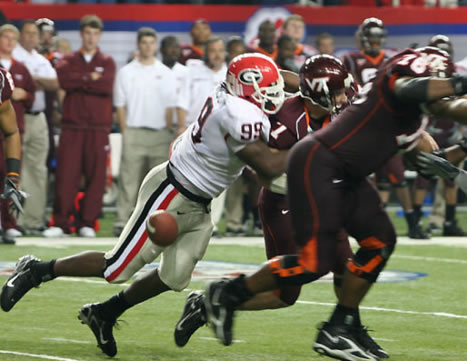
Photo: UGASports.com
Thursday April 12, 2007
Back in February, I listed the proposed rule changes for college football. The proposed changes still had to be approved by an NCAA oversight committee, and that’s now taken place. While the vast majority of the changes were approved as-is, there are also some new developments.
The main point is that 3-2-5-e is dead. Good.
One proposal that didn’t make it through was a plan to limit official reviews (replays) to 2:00. Citing “the potential for technical difficulties,” the rules committee withdrew this proposal. It’s not really a big deal as replays averaged just 1:49 last year. I maintain that the policy of reviewing every play is a bigger issue. It’s not that replays take too long in most cases – there are sometimes just too many plays being reviewed.
The talk of a 40-second play clock keeps coming around.
The committee will also begin considering a play clock that alternates between 40 seconds and 25 seconds, depending on whether the clock has stopped. The NFL uses that system, and the committee thinks it could speed up games.
We’re going to end up with a system here in a couple of years where the play clock is 40 seconds in some cases, 25 in others, and 15 in the rest. Choose one. The guys on the field have enough to worry about without wondering if this is the second snap after the full moon and whether or not they have to get the play off in 10 seconds or 45 seconds.
Tuesday April 10, 2007
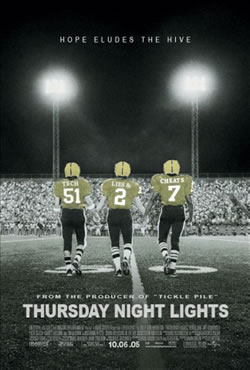 pwd is doing his usual strong job staying on top of the TV schedule puzzle, but one thing is certain: Georgia will not be playing on Thursday nights. pwd is doing his usual strong job staying on top of the TV schedule puzzle, but one thing is certain: Georgia will not be playing on Thursday nights.
Athletic director Damon Evans made it pretty clear that Georgia has its limits on how far it will go for TV exposure.
“As long as I’m the athletic director here, we won’t have Thursday night football, plain and simple,” athletic director Damon Evans told the University Council’s Committee on Intercollegiate Athletics last month.
Thursday night games are worth an extra $500,000 per school, Evans said, but also mean more class time missed for players, thousands of students out late on a week night and the campus disrupted by fans streaming into town early to tailgate.
Evans neglects to mention Georgia’s state-wide fan base who would also be inconvenienced by mid-week games, but fans haven’t been part of the scheduling equation for some time now.
With the trend towards more midweek games showcasing lesser teams who would play at 3:00 a.m. on Tuesday morning if ESPN said so, it’s a good development to see someone stand up to it. Let other teams play on Thursday. College football belongs on Saturday.
Thursday April 5, 2007
Billy Donovan is staying at Florida. As most outside of Lexington expected, he’s simply going to play the situation into a nice extension at Florida.
There is hope though for the rest of the college basketball world. Florida’s four star underclassmen Joakim Noah, Al Horford, Corey Brewer, and Taurean Green are expected to announce later today that they will declare for the NBA draft.
Thursday April 5, 2007
Cori Chambers’ hometown paper writes about her selection in yesterday’s WNBA draft. At Connecticut, she’ll only be an hour or so away from her family.
Savannah’s paper weighs in on a hometown issue of their own. Sonny Seiler has more to say about the future of Uga VI and maintains that there are no set plans to retire him.
Monday March 26, 2007
Swinging an axe that would make George Steinbrenner proud, outgoing Arkansas
AD Frank Broyles is cleaning house before he turns in the keys.
Broyles announced
his retirement on February 17th, but the retirement will not take effect
until the end of 2007. Broyles’ retirement announcement came in the midst of
a storm of controversy surrounding the football program which began with interference
from parents and resulted in the transfer of star QB Mitch Mustain and the
demotion and eventual departure of offensive coordinator Gus Malzahn.
Then women’s basketball coach (and UGA alum) Susie Gardner "resigned"
following a loss in the SEC Tournament in early March.
Today, the carnage continued with the firing
of men’s basketball coach Stan Heath. Arkansas’ run to the finals of the
SEC Tournament and a berth in the NCAA Tournament were not enough to save Heath.
Heath was 82-71 in five seasons and had reached the 2006 and 2007 NCAA Tournaments.
It’s speculated that Arkansas will target Texas A&M’s Billy Gillespie.
Football coach Houston Nutt remains one of the few survivors, but even he is
on shaky ground despite an SEC West title last season. With all of the drama
around the football program and the changes going on in other programs, the
future of Nutt might be one of Broyles’ last decisions as he exits in December.
Thursday March 22, 2007
FoxSports.com is reporting that Kentucky basketball coach Tubby
Smith has been forced out and will take the vacant job at Minnesota. Not
at Michigan – at Minnesota.
I’m not one to dance on graves. As a relatively ambitious man, I can understand
why Tubby left Georgia for Kentucky. But I’m certainly not sad for him and definitely
not sympathetic with the Cats. With the greater prestige of the job comes greater
expectations and pressure. Now is the Minnesota situation in 2007 better than the
situation Tubby came into at Georgia in 1995? I don’t think so.
The college basketball world now waits to see if Billy Donovan will turn down
the job.
Perhaps Tubby can continue his legacy at Kentucky much the same way he did
at Georgia with a recommendation for his successor. Ron
Jirsa is available.
Friday March 16, 2007
We continue today’s legislative roundup with this nugget. Eight wins at most
top football programs, if done consistently, gets you fired. One eight-win season
gets the fans grumbling…even a nine-win season leaves some natives restless.
Not at South Carolina.
Eight wins gets you an increase
in ticket prices and also a glowing pat on the back from the South
Carolina state house:
A HOUSE RESOLUTION
TO CONGRATULATE UNIVERSITY OF SOUTH CAROLINA HEAD FOOTBALL COACH STEVE SPURRIER
AND THE UNIVERSITY OF SOUTH CAROLINA FOOTBALL TEAM FOR AN OUTSTANDING 2006
SEASON WHICH CONCLUDED WITH A TOTAL OF EIGHT WINS INCLUDING A VICTORY OVER
HOUSTON IN THE LIBERTY BOWL, IN MEMPHIS, AND FOR BRINGING TO THE GAMECOCK
PROGRAM A RENEWED SENSE OF PRIDE AND ACCOMPLISHMENT.
Read
the whole thing. It gets better. They commend him for winning a Heisman
and titles at a competing school…in a different state. This might
also be the first mention of recruiting analysts in a legislative resolution.
It needs to be investigated whether the phrase "the University of South
Carolina football team recently concluded an outstanding 2006 season with eight
wins including a thrilling high-scoring victory over Houston in the Liberty
Bowl in Memphis" can be challenged in court. I expect to see it in negative
campaign ads against the sponsors of the resolution.
As much as we know about Spurrier, this resolution probably didn’t come as
an honor to him; it was surely an embarrassment to him that these overzealous
fans in the state house would fawn all over an eight-win season and a "thrilling"
Liberty Bowl win.
Such a legislative act isn’t unprecedented though. We’ve obtained an etching of the Continental Congress in Philadelphia deliberating a resolution to honor Joe Paterno’s first bowl win.
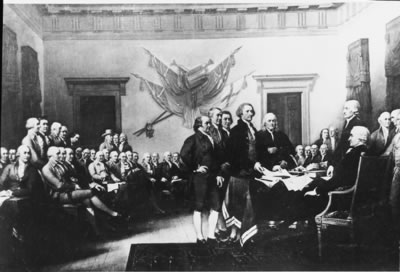
Friday March 16, 2007
The Banner-Herald reports that some Georgia legislators are trying to use legislative
pressure to revive
intercollegiate wrestling programs in the state. The University of Georgia
dropped its program in 1980, and Georgia State in 1998 was the last state school
to drop its program.
Republican state Senator Seth Harp of Midland is behind the effort. He says,
"We’ve had a number of people who made inquires about having a wrestling
program. We’re losing some very fine students to out-of-state schools."
That might be true, but I’d be a lot more concerned about the "very fine
students" who are leaving the state because of the quality of
Georgia public higher education rather than the availability of a wrestling
program.
Look, I have nothing against Georgia colleges having a wrestling program. Georgia
has a strong high school program. There are lots of other sports I’d like to
see added too. We just have a few realities to face:
- Funding. The University of Georgia’s athletic association
is in the black, but it’s an exception. Tech is struggling and working through
financial issues. Other state colleges can’t be raking in the cash. How do
these legislators propose we fund these programs?
- Title IX. This is really the big gorilla in the room. There
aren’t many schools who don’t struggle with the requirements of Title IX.
Few schools are totally compliant, and even those who come close do so with
a careful balancing act. UGA’s recent addition of a large equestrian program
was surely motivated with an eye towards increasing the number of female student-athletes.
In a nod to the Missouri Compromise, schools attempting to keep the balance
required by Title IX can’t add scholarships for male athletes without adding
them for females. No, that doesn’t mean a female wrestling program or a coed
program; it means that adding wrestling would probably have to come hand-in-hand
with another female sport. So the funding problem is now a problem times two.
Sen. Harp can’t be all bad; he’s a driving force behind reforming
the remaining Blue Laws, and I support him completely on that issue. He
just needs to think this wrestling thing through a bit. "Coach Goldberg"
doesn’t sound too bad though.
Friday March 9, 2007
The SEC
Tournament’s first round saved its most interesting game for last. The first
three games went as expected and were solid double-digit wins for the favorites.
Things get more intense today as the top four seeds join the action. LSU’s upset
win over Tennessee ensures that at least one SEC West team will advance to the
semifinals, but will there be another?
- Kentucky 79 – Alabama 67. The Cats had a pretty easy time
with the Tide, and it didn’t help Alabama that Steele was limited. You just
can’t overstate Kentucky’s comfort playing in the SEC Tournament. They’re
not the best team here, but they are used to advancing. Their omnipresent
fans give them a lift. Even in a down year, why shouldn’t they be expected
to reach the semifinals? Alabama, on the other hand, put the finishing touches
on a disappointing season. Last year’s NCAA Tournament run notwithstanding,
they tend to be one of the league’s biggest paper tigers from year to year.
- Arkansas 82 – South Carolina 52. The Hogs have been tough
to figure out this year, but they too had few problems in their opener. South
Carolina is a much lesser team away from home, and it showed in this game.
They didn’t shoot well, got outrebounded, and couldn’t create turnovers. Arkansas
hit 12 more shots and dominated the second half. Arkansas seems like a solid
NIT team, but it’s looking less likely that the Gamecocks will get an opportunity
to become a three-time repeat NIT champion.
- Georgia 80 – Auburn 65. The Dawgs grabbed control of this
one late in the first half and held the lead in double-digits during the second
half. They overmatched Auburn at most every position and were effective inside
and outside. Auburn has improved this year much like Georgia, and they had
won three of their last four entering the tournament. But Georgia showed again
that they have come further and are the better program.
- LSU 76 – Tennessee 67 (OT). Tennessee coach Bruce Pearl
recognized the trouble early. This game was played exactly to LSU’s pace –
low-scoring and in the halfcourt. Tennessee had no answer for Big Baby Davis
inside – he dominated on offense and affected what the Vols wanted to do on
the other end of the court. Davis’s presence forced Tennessee to rely on their
strength – the three-point shot, but it let them down in this game. They shot
just 23% from outside, and guards Wayne Chism and JaJuan Smith combined for
a dreadful 0-12 from outside. Even sharpshooting Chris Lofton only hit three
from behind the arc. The Tigers had the game won in regulation, but poor rebounding
and a horrible call actually gave Tennessee a chance to attempt the game-winning
shot. LSU closed the door in overtime, and Davis ensured that there would
be no second comeback. Though they struggled for much of the season, LSU showed
how dangerous a team can be in the postseason with a single dominant player.
Ole Miss should be a bit nervous. Wins at Arkansas and Georgia helped to limit
concerns about Tennessee’s play away from home, but those same questions have
to be asked again with their NCAA seeding at stake.
|
 Parrish: SEC dusts off the robes
Parrish: SEC dusts off the robes




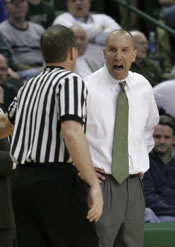


 Dawg Media
Dawg Media